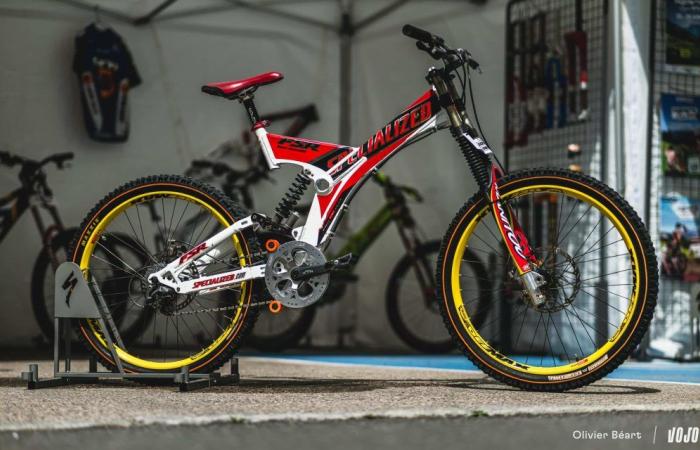The Pass’Portes du Soleil is celebrating its 20th anniversary this year! What has now become one of the most popular events in the mountain biking world celebrated its anniversary with an exhibition of vintage downhill bikes, which trace the evolution of gravity mountain biking over the last two decades. Vojo takes you to discover these gems:
At the helm of this vintage mountain bike exhibition which commemorates the 20th anniversary of the Pass’Portes, we find Pierre-Adrien Auffret. Passionate about the Sunn brand at the start, he started his collection with bikes from the St-Gaudens brand like this Team Chipie Replica that he holds here in his hands.
Later, he oriented his collection a little more towards downhill bikes and other “gravity” practices. Many collectors are more XC oriented. I too like it a lot and I also have some, but coming from BMX and having always really liked DH, I have collected over the years some beautiful nuggets which marked their era, as well as some accessories and frame plaques from the 20 editions of Pass’Portes to link with the event. »
« The hardest part is choosing! I was limited by the space in my van for transport to Châtel (I come from Brittany), otherwise, I would have taken more. In my selection, I tried to take mythical bikes and/or which allow us to show the evolution of DH over the years, with increasingly technological bikes. explains Pierre-Adrien.
Exactly, let’s examine its nuggets!
GT LTS DH – 1995
We are here at the beginning of bikes and accessories designed (a little) more specifically for downhill riding. “ But there are still a lot of common points with the XC bikes of the time,” explains Pierre-Adrien. “ The frame is identical to the XC model and only has 80mm of rear travel, and the RockShox Judy fork may be the DH version, it only has 63mm of travel, and it remains very close to the that it is made of coil springs inside and not of elastomers. »
We also notice that the brakes are simple cantilevers (Shimano XTR all the same). The wheels are fitted with the widest rims produced by Mavic at the time, and with ceramic sidewalls to improve stopping power. The Michelin DH tires, on the other hand, are well designed for practice and they were one of the only “gravity” pieces of equipment at the time.
We also note the superb GT TechShop single-chainring crankset, only available as a separate accessory at the time, and the STM anti-derailment system for this bike which is an almost exact replica of the one with which Nicolas Vouilloz won his world title in 1995 in Métabief.
GT LTS DH – 1997
We take almost the same, and we start again! The evolutions on the frame are subtle (look for example at the curved seat tube) but the GT LTS frame becomes specific for downhill in 1997 and it now develops 100 mm of travel. It is a turning point: we begin to develop more specific products for the practice.
This is also noticeable in the equipment. The most visible is the RockShox Judy DHO fork, the ancestor of the Boxxer, which goes to double crown while remaining in small 28 mm stanchions, but which adopts a large diameter through axle. The RockShox shock absorber adopts a high-end coil spring, also developed specifically for downhill. These colors are also reminiscent of those of the latest gravity products from RockShox, which remain proud of their roots.
Another big development is the move to disc brakes! The frame still has its V-Brake attachment points and the disc tab is a simple add-on part, screwed onto the frame. But still! Hope is a pioneer in this area.
GT STS Lobo DH – 1998
The evolution is this time dazzling with the GT STS Lobo, a real beast developed especially for downhill and which still impresses today. Its thermoplastic frame with aluminum reinforcements has become iconic and it is a perfect example of the rise of downhill racing in the late 90s.
Travel increases to 180mm with a specific suspension with a “pulled” shock. Also note the disc brake caliper mounted “floating” to avoid interfering with the operation of the suspension. The bike deviates a little from the “catalog” assembly (in RockShox) to sport the enormous Marzocchi Monster which stands out with its 36mm diameter stanchions. This may seem common today, but it was a big novelty for the time.
Specific rims for disc braking are appearing, accompanied by new wider and more voluminous Michelin tires, the legendary DH16 and DH24. Finally, we also note the specific anti-derailment manufactured by AC, an equipment manufacturer with which GT collaborated extensively during this period.
Sunn Radical+ – 1998
No, it’s not just a GT exhibition, there were many bikes from other brands, don’t worry! As evidenced by this Sunn Radical+, another legendary DH bike from the end of the 90s. This is the “stock” version and not one of the prototypes ridden by Nico Vouilloz or Anne-Caroline Chausson, but all likewise !
The Sunn Radical+ stands out with its steel perimeter frame, heavily inspired by motorcycles. At that time, few DH bikes were made of steel. Most were made of aluminum and a few rare models were made of carbon like the GT Lobo shown just before.
Its suspension, designed by Olivier Bossard, is also inspired by motorcycles. It uses a specific Showa shock absorber, and the Obsys inverted fork is also developed by BOS. As we can see, this bike has been the subject of a lot of R&D work specific to the practice.
Specialized FSR DH – 1999
Specialized has always been present in DH, and this FSR model has remained in history thanks to the whimsical Shaun Palmer, a true rock star of downhill, who contributed to the development of the discipline as much through his riding as by his exuberant style off the bike. His bike was one of the first to be this long and to have more recumbent angles.
Note the numerous adjustment possibilities at the shock absorber anchoring points to vary the operation of the suspension and/or the geometry depending on the track. Yes, even back then, this was happening! The travel is 200mm. At the front, the fork is the splendid Manitou X-Vert Triple, which stands out with its carbon blades. On the other hand, its divers remain only 30 mm in diameter.
The rest of the equipment is fairly standard, with a Shimano XTR transmission, but we note the presence of Hayes disc brakes, quite popular in DH at the time, as well as the first yellow Mavic Deemax and Maxxis DH tires.
Giant ATX One – 1999
Even if its “banana” suspension was common with XC bikes of the time, the Giant ATX One is also a DH bike whose shape and colors marked its era. The front triangle combines a “beam” architecture for the upper part and a reinforcing “bar” on the lower part. It was piloted notably by Myles Rockwell.
The fork is the RockShox Boxxer, the first version of which appeared a year earlier. Also look at the first generation Magura Gustav M brakes, which were among the first in 4 pistons. A fun nod to the time when the German brand has just presented the very latest version of the Gustav!
Tomac 204 Magnum – 1999
John Tomac’s team was never as successful as its illustrious creator, but his bikes were true works of art. Witness this 204 Magnum DH with its impressive frame and single-arm suspension with linkage inspired by the motorcycle, designed with Doug Bradbury, the “father” of the Manitou brand.
The fork is the spectacular inverted Manitou Dorado, with 200mm of travel. The MRD (Manitou Racing Development) stem is specific and Pierre-Adrien had to buy another complete bike to finally find it and have a perfect fitment on his 204 Magnum.
This is an opportunity to highlight the enormous amount of research that went into rebuilding these bikes in a way that was consistent with their era. Very often, there is a lot of restoration work to be done to get the machine back into shape, and it sometimes takes years of patience to find all the period parts. Especially in DH where the bikes were almost prototypes offered for sale and some equipment was produced in a very small number of copies. A bike is rarely completely finished, there is always a small part missing somewhere for the assembly to be perfect,” explains Pierre-Adrien.
Kästle Team DH – 2001
We’re heading back to the 2000s with this Kästle Team DH which is completely new, since it has never been driven! It stands out with its aluminum perimeter frame and its single-arm motorcycle suspension, a sort of evolution of the path opened by Sunn and then also taken up by Ancillotti and Sintesi.
He rode with the Marzocchi Shiver, which took over from the Monster in DH competition and which went into reverse mode.
The eye is also drawn to the Race Face DH crankset and the second generation Magura Gustav M brakes with their famous yellow levers.
GT DHi Team – 2002
And we finish as we started, with a GT! You will have understood, Pierre-Adrien is particularly fond of this brand, which has indeed counted a lot in the history of the DH. This is the DHi Team from 2002.
Although it may seem quite simple, its suspension actually hides the ingenious iDrive system. This is a kinematic system with a “floating” bottom bracket, developed by GT to combine the advantages of the unified rear arm (constant chain length, good efficiency), without the disadvantages (suspension blocked when you get up from the saddle).
The visit is now over, but if you wish to continue the discussion, you can find Pierre-Adrien and several thousand other vintage mountain bike enthusiasts on the VTT Vintage – Old School group that he launched several years ago on Facebook : https://www.facebook.com/groups/1743475722533650/buy_sell_discussion






